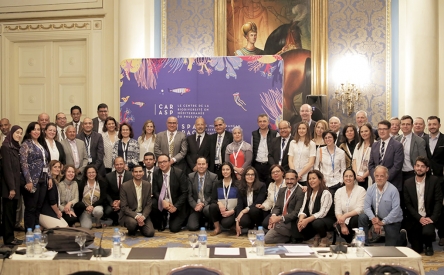Search
05/17: Mediterranean countries discuss the conservation of biological diversity in the region
The Focal Points for Specially Protected Areas held their 13th meeting in Alexandria, Egypt, from 9 to 12 May 2017
The Focal Points of the UN Environment/Mediterranean Action Plan Regional Activity Centre for Specially Protected Areas (UN Environment/MAP-SPA/RAC), representing the 21 Mediterranean riparian countries and the European Union, held their 13th meeting in Alexandria, Egypt, from 9 to 12 May 2017. Representatives of four regional institutions and organizations (ACCOBAMS, IUCN-Med, MedPAN and Oceana) were also present at the meeting as observers.
The meeting reviewed technical documents that would be forwarded to the MAP Focal Points meeting for endorsement, then to the 20th Ordinary Meeting of the Contracting Parties of the Barcelona Convention for adoption in December 2017.
The meeting was opened by Mr. Khalil Attia, SPA/RAC director, who presented the progress achieved by the centre throughout the last two years: “the biennium had been prosperous in terms of activities undertaken. However, Mediterranean biodiversity is facing major challenges and the coming years would be critical at many levels”. Mr. Attia welcomed existing and future collaboration with many organizations, which would help in achieving common regional objectives.
Thanking Egypt for its kind hospitality, Mr. Gaetano Leone, Coordinator of the UN Environment/MAP highlighted that biodiversity and the ecosystem approach are at the core of the work of the Mediterranean Action Plan system and Mid Term Strategy for 2016-2021. He said: “the improvement of the quality of the marine environment remains the priority objective of the Barcelona Convention, with the commitment to achieve Good Environmental Status and integrate the ecosystem approach in the management of human activities. The situation in the region remains challenging in terms of biodiversity conservation and achieving the global goals for the effective extension and management of marine protected areas. Mediterranean ecosystems continue to be degraded, but with small although relevant steps, we will achieve our common ambitious goal.”
Dr. Mona Mohamed Kamal, Chief Executive Officer of the Egyptian Environmental Affairs Agency (EEAA), said in her welcoming address: “in spite of all efforts, marine biodiversity suffers from various sources of pressure. A greater response is needed, such as implementation of national and regional action plans”. Dr. Mona Mohamed Kamal declared that Egypt had elaborated its national action plans on marine biodiversity monitoring, marine mammals, turtles, non-indigenous species and management of marine protected areas (MPA). Finally, H.E Mr Mohamed Sultan, Governor of Alexandria welcomed the participants to the meeting.
Participants endorsed a number of documents and recommended their submission to the 20th Conference of the Parties to the Barcelona Convention (COP 20) for adoption. Once adopted, these documents will serve as reference documents to further enhance and improve national policies concerning the conservation of the marine and coastal biodiversity in the Mediterranean Sea.
These included an updated Action Plan for the Conservation of Marine and Coastal Bird Species listed as endangered and threatened species in the Protocol concerning Specially Protected Areas and Biological Diversity in the Mediterranean, as well as proposals to add four Anthozoa species (Isidella elongata, Dendrophyllia cornigera, Dendrophyllia ramea and Desmophyllum dianthus), who live mainly in deep-sea zones, to Annex II to the SPA/BD Protocol. The inclusion to the Annex II of these species would encourage the creation of MPAs in deep seas.
Factsheets on the progress of implementation of the Integrated Monitoring and Assessment Programme (IMAP) related to Biodiversity and Non-Indigenous Species (NIS), were also among the documents to be sent to the COP 20 for adoption. That process will allow to regularly quantify how good the status of conservation of the whole Mediterranean environment is.
In addition, two proposals of areas for inclusion in the List of Specially Protected Areas of Mediterranean Importance will be submitted to the COP 20. Those are the Calanques National Park, France, and the Cetaceans Migration Corridor, Spain, once its legal status is established.
Furthermore, the meeting agreed to the request received from the Tunisian NGO “Notre Grand Bleu” to become a partner in the action plan for the conservation of marine turtles.
During the meeting, SPA/RAC presented its new online tool, “the Mediterranean Platform on Marine Biodiversity”. The platform has three main features: (i) thematic maps organised in various themes, such as Mediterranean MPA and Specially Protected Areas of Mediterranean Importance; (ii) a catalogue, containing the metadata of the 150 layers already included in the platform; and (iii) creating user’s maps by selecting data from the catalogue.
The next focal points meeting for Specially protected areas is expected to be organised in mid-2019.
*Photos of the meeting are available here: https://flic.kr/s/aHskWBBgrJand on SPA/RAC Facebook and Twitter pages @SPARACinfos.




Find Us On...